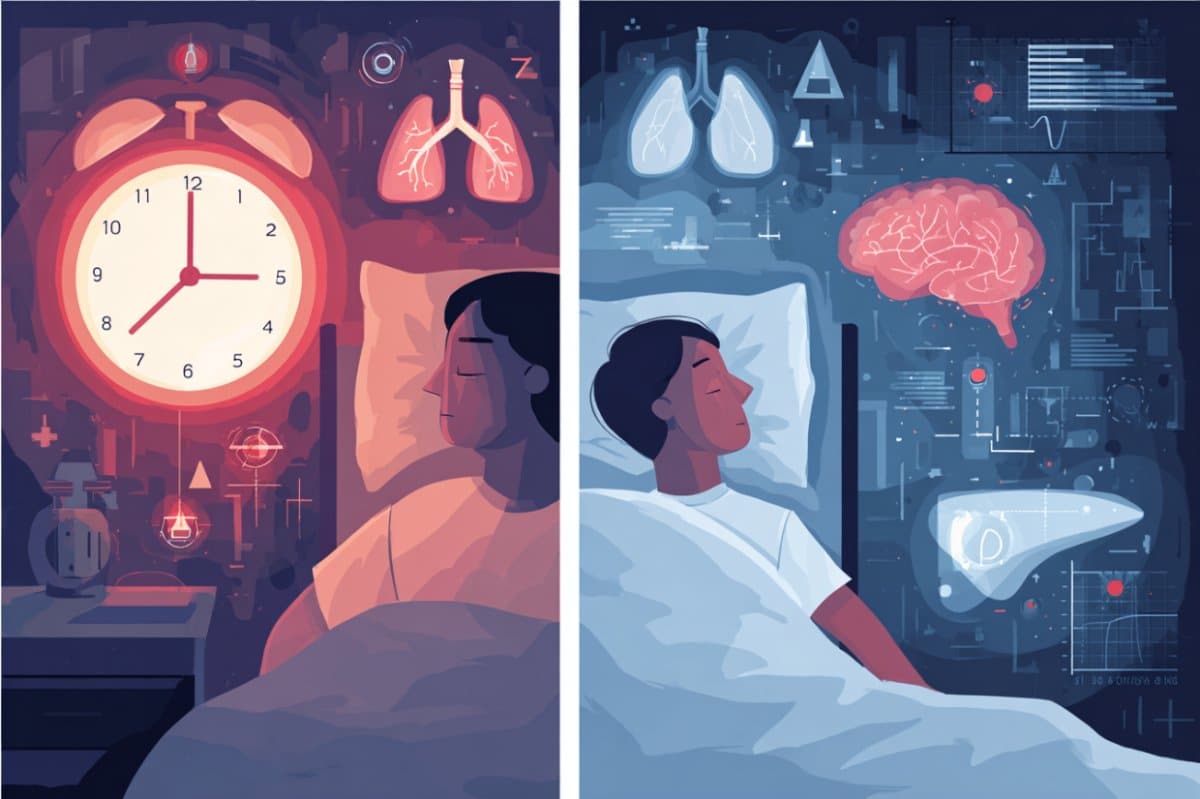Key Questions Answered
Q: What did this study reveal about sleep and health?
A: An analysis of sleep data from over 88,000 people found that poor sleep patterns—especially irregular bedtimes and unstable circadian rhythms—were linked to elevated risk for 172 different diseases.
Q: Which sleep traits were most harmful?
A: Going to bed after 12:30 a.m. and having low sleep regularity significantly raised the risk for serious conditions like liver cirrhosis and gangrene, among many others.
Q: What about long sleep—was it harmful?
A: Contrary to prior belief, objective data showed long sleep wasn’t linked to poor health in most cases; many self-reported “long sleepers” were actually sleeping very little, just lying in bed longer.
Summary: In the largest study of its kind, researchers linked irregular sleep patterns to elevated risk for 172 diseases. Using objective sleep data from actigraphy devices worn by over 88,000 people for nearly seven years, the study found that erratic bedtimes and poor circadian stability were among the most damaging traits.
People with irregular sleep schedules had significantly higher risks for serious conditions, including liver cirrhosis and gangrene. The findings challenge previous assumptions about long sleep being harmful and spotlight sleep regularity—not just duration—as a critical factor in long-term health.
Key Facts:
- Widespread Impact: Poor sleep regularity was linked to 172 diseases.
- High Risk: Irregular bedtime raised liver cirrhosis risk 2.57x; low rhythm stability raised gangrene risk 2.61x.
- Myth Debunked: Most “long sleepers” actually had poor sleep efficiency—not longer sleep.
Source: Health Data Science
A groundbreaking international study, recently published in Health Data Science, analyzed objective sleep data from 88,461 adults in the UK Biobank and found significant associations between sleep traits and 172 diseases.
The research, led by teams from Peking University and Army Medical University, highlights sleep regularity—such as bedtime consistency and circadian rhythm stability—as an underrecognized but critical factor in disease risk.

Using actigraphy data over an average of 6.8 years, researchers identified that 92 diseases had over 20% of their risk attributable to poor sleep behavior. Notably, irregular bedtime (after 00:30) was linked to a 2.57-fold higher risk of liver cirrhosis, while low interdaily stability increased the risk of gangrene by 2.61 times.
Importantly, the study challenges previous claims that “long sleep” (≥9 hours) is harmful. While subjective reports have linked long sleep to stroke and heart disease, objective data revealed this association in only one disease. Misclassification may be to blame: 21.67% of “long sleepers” actually slept less than 6 hours, suggesting that time spent in bed is often confused with actual sleep time.
“Our findings underscore the overlooked importance of sleep regularity,” said Prof. Shengfeng Wang, senior author of the study. “It’s time we broaden our definition of good sleep beyond just duration.”
The team confirmed several associations in U.S. populations and identified inflammatory pathways as a possible biological link. Future research will explore causality and assess the impact of sleep interventions on chronic disease outcomes.
About this sleep and health research news
Author: Mai Wang
Source: Health Data Science
Contact: Mai Wang – Health Data Science
Image: The image is credited to Neuroscience News
Original Research: Open access.
“Phenome-wide Analysis of Diseases in Relation to Objectively Measured Sleep Traits and Comparison with Subjective Sleep Traits in 88,461 Adults” by Yimeng Wang et al. Health Data Science
Abstract
Phenome-wide Analysis of Diseases in Relation to Objectively Measured Sleep Traits and Comparison with Subjective Sleep Traits in 88,461 Adults
Background: Sleep traits have been suggested to correlate with various diseases, but most evidence is based on subjective sleep measurement.
We investigated the associations of accelerometer-derived objective sleep traits with diseases throughout physiological systems to ascertain whether the disease spectrum related to objective sleep traits differs from that related to subjective sleep traits.
Methods: In 88,461 UK Biobank (UKB) adults wearing accelerometers, multiple dimensions of sleep were objectively derived: (a) nocturnal sleep duration and onset timing, (b) sleep rhythm (relative amplitude and interdaily stability), and (c) sleep fragmentation (sleep efficiency and waking numbers).
Associations with International Classification of Diseases, 10th Revision–decoded diseases during follow-up were estimated using the Cox model, and the results were compared with those of a published literature search of subjectively measured sleep traits and diseases.
National Health and Nutrition Examination Survey (NHANES) data were used to validate the newly identified associations unreported by previous studies. For the meta-analysis-reported associations (with subjective sleep traits) that were negative (with objective sleep traits) in our study, reanalysis was done in UKB with subjective sleep traits, stratified by objective measurements.
Results: During the average 6.8-year follow-up, 172 diseases were associated with sleep traits. Among them, 42 showed at least doubled disease risk, including age-related physical debility (lowest versus highest quartile of relative amplitude, hazard ratio [HR] = 3.36, 95% confidence interval [CI]: 2.25, 5.02), gangrene (lowest versus highest quartile of interdaily stability, HR = 2.61, 95% CI: 1.41, 4.83), and fibrosis and cirrhosis of the liver (sleep onset timing ≥0030 versus 2300 to 2330, HR = 2.57, 95% CI: 1.42, 4.67).
A total of 92 diseases had >20% burden attributable to sleep, such as Parkinson’s disease (37.05%, 95% CI: 21.02%, 49.83%), type 2 diabetes (36.12%, 95% CI: 29.00%, 42.52%), and acute kidney failure (21.85%, 95% CI: 13.47%, 29.42%). Notably, 83 (48.3%) disease associations were sleep rhythm specific, distinct from existing subjective-measure literature that focused on sleep duration.
Reanalysis in UKB showed a contamination of objectively short sleepers in self-report long sleepers, which induced false-positive associations in subjective meta-analyses, including for ischemic heart disease and depressive disorder.
Newly identified associations of sleep rhythm with 4 diseases including chronic obstructive pulmonary disease and diabetes were successfully replicated in NHANES. A mediation analysis showed that inflammatory factors including leukocytes, eosinophils, and C-reactive protein contributed significantly to all these newly identified sleep–disease associations.
Conclusions: Objective sleep traits showed a disease spectrum similar to but not identical to that of subjective sleep traits. Objective measurement can be a useful complement to sleep–disease studies as it may help overcome false-positive associations caused by misclassification bias of some subjective measurement such as sleep duration. Comprehensive control of multiple sleep traits may be important for health as substantial disease burden was attributed to different sleep traits.






